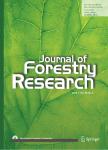Status and distribution pattern of coarse woody debris along an altitudinal gradient in Askot Wildlife Sanctuary, Uttarakhand, West Himalaya
Status and distribution pattern of coarse woody debris along an altitudinal gradient in Askot Wildlife Sanctuary, Uttarakhand, West Himalaya作者机构:Department of Habitat Ecology Wildlife Institute of India Chandrabani Dehradun 248 001 Uttarakhand India
出 版 物:《Journal of Forestry Research》 (林业研究(英文版))
年 卷 期:2009年第20卷第A3期
页 面:205-212页
核心收录:
学科分类:0907[农学-林学] 090705[农学-野生动植物保护与利用] 09[农学] 0903[农学-农业资源与环境]
主 题:Askot Wildlife Sanctuary chir pine coarse woody debris rianj oak Pinus roxburghii Quercus lanata
摘 要:A rapid assessment on the status and distribution patterns of coarse woody debris (CWD) was conducted by laying five curvilinear transects (transects A, B, C, D and E; major trails), along an altitudinal gradient starting from 900 to 2 600 m, in three major watersheds (Charigad, Dogarhigad and upper Gosigad) of Goriganga catchment in Askot Wildlife Sanctuary, India. At every 100 m rise in altitude a hectare plot (100 m x 100 m) was selected. Results showed that the percentage contribution by different succession phases was in the decreasing order: phase I 〉 phase II 〉 phase IV 〉 phase III for snags, and phase III〉 phase II 〉 phase IV 〉 phase I for logs. Snag density in chir pine forest was high in transect A (11 snags'ha^-1) at 1 500 m, and the value in rianj oak forest was high in transect B (10 ***-l) at 2 300 m. The total available mass of snags and logs in chit pine forest was 13.9 t, of which snags mass accounted for 41% of the total mass and logs mass for 59%. While the total value was 5.6 t in rianj oak forest, of which snags and logs accounted for 60% and 40% of the total mass, respectively. Moreover, the presence of CWD in the study area if not harvested, would provide a great opportunity to the orchids in future to flourish by providing protection. The high densities of snags and logs in chir pine forest at mid-altitudinal zone led to less species richness and lower density of ground flora as the zone receives more light, accompanying with lower soil moisture, and thus only the dominant species occupy the habitat.



